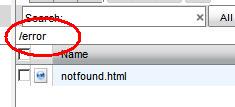Changing IIS Settings: Custom Error Pages (Legacy)
IIS
Internet Information Services (IIS) is Microsoft's Web server. You can use the IIS Administration Console to set up custom error pages.
Designate a custom page to display for 404 error
When your website visitors click on a broken link or an unfinished page link, a page is displayed with a 404 error (File or directory not found). You can customize this error page to make it look like the other pages on your site, or to make it more friendly (for example, to say that the site is under construction and will be up shortly), and/or include a redirect to your home page. Here is an example 404 page from dzineblog.com:

This example assumes that you created an error directory and your own error page, called it notfound.html, and placed it in the /error/ directory.

Note: Note the path to your file, displayed in FileManager, circled in red, on the picture above. In this case, it's /error; yours may say /public_html/error or /ht_docs/error. You will need this full path, as it is displayed. In this example, the full path to the error file is: /error/notfound.html
- Log in to the IIS Administration Console.
- Open the Custom Error Pages section.
- Enter the path to the custom error page from your home directory in the form /notfound.html or /error/notfound.html
Important: You must enter the path to a specific html file. Entering only a directory path, such as /error, will not work for custom error pages.
- Click Set Custom 404 Page.
- To return to the default page, clear the field, and then click Set Custom 404 Page.
Note: Setting changes take up to 2 hours to take effect.